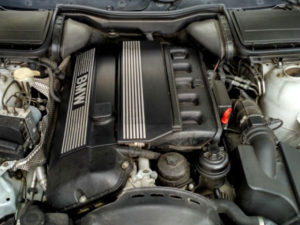
The M52B28 TU engine features a cast-aluminum alloy cylinder block with cast-iron cylinder liners. The aluminum cylinder head uses chain-driven double overhead camshafts (DOHC) and four valves per cylinder (24 valves in total). It is equipped with a Siemens MS 42.0 DME (Digital Motor Electronics) system, double VANOS (Variable Valve Timing System from BMW) for both inlet and exhaust camshafts, Motor Driven Throttle Valve, dual length intake manifold (called “DISA” by BMW) and a distributorless ignition system with individual ignition coils for each cylinder.
This engine has an 84.0 mm (3.31 in) cylinder bore and 84.0 mm (3.31 in) piston stroke. This engine has a compression ratio of 10.2:1 and a redline of 6,500 rpm. It produced 193 PS (142 kW; 190 HP) at 5,300 rpm of maximum horsepower and 280 N·m (28.6 kg·m, 206.4 ft·lb) at 3,500 rpm of peak torque.
The breakdown of the engine code is as follows:
- M52 – Engine Family
- B – Gasoline
- 28 – 2.8 Liter Displacement
- TU – Technical update
General information
| Engine Specifications | |
| Engine code | M52B28TU |
| Layout | Four stroke, Inline-6 (Straight-6) |
| Fuel type | Gasoline |
| Production | 1998-2000 |
| Displacement | 2.8 L, 2,793 cc (170.44 cu in) |
| Fuel system | Fuel injection system |
| Power adder | None |
| Max. horsepower | 193 PS (142 kW; 190 HP) at 5,300 rpm |
| Max. torque | 280 N·m (28.6 kg·m, 206.4 ft·lb) at 3,500 rpm |
| Firing order | 1-5-3-6-2-4 |
| Dimensions (L x H x W): | – |
| Weight | ~175 kg (385 lbs) |
Cylinder block
The M52B28TU cylinder block is cast aluminum alloy with cast iron cylinder liners, bore is 84.0 mm (3.31 in) and stroke is 84.0 mm (3.31 in). The compression ratio rating is 10.2:1. The cylinders are exposed on all sides to circulating coolant. The forged steel counterweighted crankshaft rotates in replaceable split-shell main bearings. This engine used seven main bearings.
The forged steel connecting rods use replaceable split-shell bearings at the crankshaft end and solid bushings at the piston pin end. The pistons are of the three-ring type with two upper compression rings and a lower one-piece oil scraper ring. Full-floating piston pins are retained with circlips. The M52B28TU use a graphite coating on the piston skirts to reduce friction and noise.
| Cylinder block | ||
| Cylinder block alloy | Aluminum alloy | |
| Compression ratio: | 10.2:1 | |
| Cylinder bore: | 84.0 mm (3.31 in) | |
| Piston stroke: | 84.0 mm (3.31 in) | |
| Number of piston rings (compression / oil): | 2 / 1 | |
| Number of main bearings: | 7 | |
| Cylinder inner diameter (standard): | 84.000-84.010 mm (3.3071-3.3075 in) | |
| Piston skirt diameter (standard): | 83.980-83.989 mm (3.3063-3.3066 in) | |
| Piston pin outer diameter: | 22.000 mm (0.8661 in) | |
| Piston ring side clearance: | Top | 0.020-0.060 mm (0.0008-0.0024 in) |
| Second | 0.030-0.065 mm (0.0012-0.0026 in) | |
| Oil | 0.020-0.060 mm (0.0008-0.0024 in) | |
| Piston ring end gap: | Top | 0.100-0.300 mm (0.0039-0.0118 in) |
| Second | 0.200-0.400 mm (0.0079-0.0157 in) | |
| Oil | 0.250-0.500 mm (0.0098-0.0197 in) | |
| Crankshaft journal diameter: | 60.000 mm (2.3622 in) | |
| Crankpin diameter: | 45.000 mm (1.7717 in) | |
Cylinder head
The cylinder head is made of an aluminum alloy with good cooling efficiency. The M52TU B28 engine use chain-driven double overhead camshafts and four valves per cylinder. Standart head height is 140.0 mm (5.5118 in). The cylinder head employs a crossflow design for greater power and efficiency. Intake air enters the combustion chamber from one side while exhaust gasses exit from the other. This engine is equipped with double VANOS (Variable Camshaft Timing) system. VANOS is fully variable and operates independently on both intake and exhaust sides.
Intake valves are 33.0 mm (1.2992 in) in diameter and exhaust valves are 30.5 mm (1.2008 in), valve lift are 9.0 mm (0.356 in). Valve clearance is set by self-adjusting (zero-lash) hydraulic lifters for reduced valve noise and the elimination of routine valve adjustment.
| Cylinder head | ||
| Cylinder head alloy | Aluminum | |
| Valve Arrangement: | DOHC, chain driven | |
| Valves: | 24 (4 valves per cylinder) | |
| Intake/Exhaust duration: | 228°/228° | |
| Valve head diameter: | INTAKE | 33.0 mm (1.2992 in) |
| EXHAUST | 30.5 mm (1.2008 in) | |
| Valve steam diameter: | INTAKE | 6.0 mm (0.2362 in) |
| EXHAUST | 6.0 mm (0.2362 in) | |
Head tightening procedure and torque specs:
- Step 1: 40.0 Nm; 4.1 kg·m; 29.5 ft·lb
- Step 2: Turn all bolts 90°
- Step 3: Turn all bolts another 90°
Maintenance data
| Compression pressure | |
| Minimum | 10.0 kg/cm2 (9.9 bar, 145 psi) / 350 rpm |
| Compression differential limit between cylinders: | 1.0 kg/cm2 (1.0 bar, 15 psi) / 350 rpm |
| Oil system | |
| Recommended engine oil | SAE 5W-30 |
| Oil type | BMW LL-98 or LL-01 |
| Engine oil capacity (Refill capacity) | ~ 6.5 L (6.87 US. qt, 5.72 Imp. qt.) |
| Oil change interval, km (miles) | 5,000-10,000 (3,000-6,000) |
| Ignition system | |
| Spark plug | Bosch: FGR7DQP, NGK: BKR6EQUP |
| Spark plug torque: | 25 N·m (2.5 kg·m, 18.4 ft·lb) |
Vehicle applications
| Model | Years Produced |
| BMW 328i, 328Ci (E46) | 1998-2000 |
| BMW 528i (E39) | 1998-2000 |
| BMW Z3 2.8 (E36/7/8 ) | 1998-2000 |
| BMW 728i (E38) | 1999-2000 |
Be the first to comment